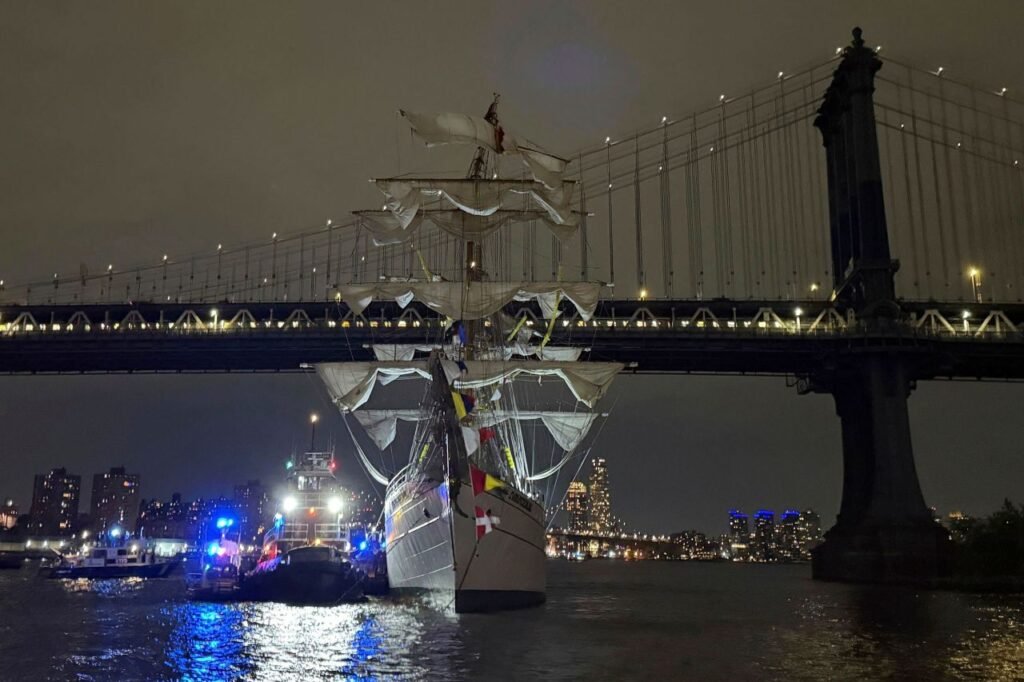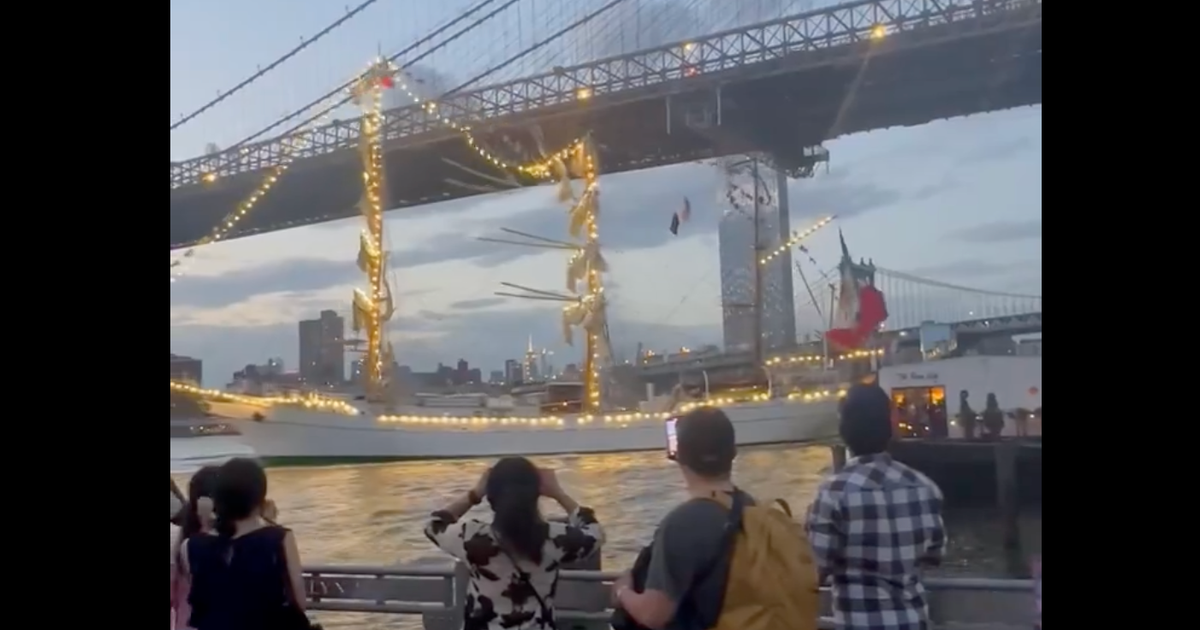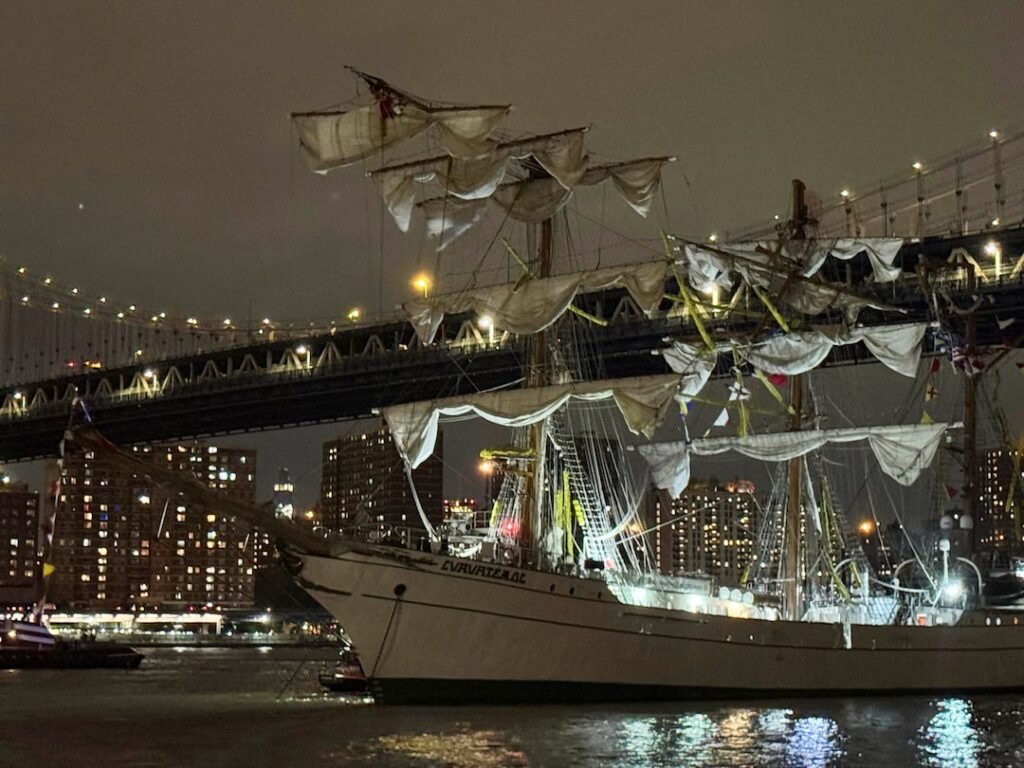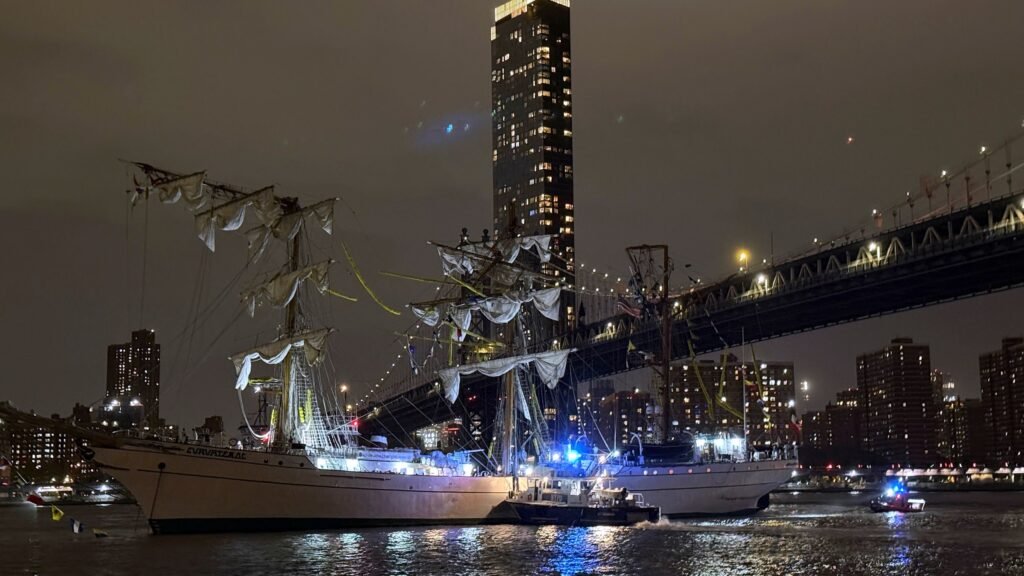Executive Summary
The Brooklyn Bridge accident on Saturday, May 17, 2025, at approximately 8:30 p.m. Eastern Daylight Time, marked a significant maritime incident in New York City’s East River. The Cuauhtémoc, a training vessel belonging to the Mexican Navy, collided with the iconic bridge during its global goodwill tour. On board were 277 individuals at the time of the incident. The collision tragically resulted in the deaths of two crew members, with at least 19 others sustaining injuries, some of which were critical.
Initial findings from authorities suggest that mechanical issues and a subsequent power cut on the vessel may have been the primary factors leading to the collision. This Brooklyn Bridge accident drew significant attention due to the iconic status of the bridge and the international nature of the ship involved. Additional coverage and details about the incident can be found in this NBC News report.Despite the impact, the Brooklyn Bridge itself did not suffer any major structural damage and was reopened to vehicular and pedestrian traffic following a thorough inspection.
The consistent reporting across numerous news sources regarding the date and approximate time of the incident provides a strong foundation of factual accuracy. The fact that multiple independent outlets converge on Saturday, May 17, 2025, around 8:30 p.m. EDT, for the collision underscores the reliability of this fundamental information. Furthermore, the detail that the vessel was engaged in a “global goodwill tour” adds a significant layer of context to its presence in New York Harbor. This detail suggests that the Cuauhtémoc’s visit was part of a broader diplomatic and cultural mission, potentially amplifying the international interest and implications of this unfortunate event.

How the Brooklyn Bridge Accident Unfolded
The collision occurred on Saturday, May 17, 2025, shortly before 9:00 p.m. or around 8:30 p.m. EDT. The location of the impact was near the Brooklyn side of the East River. The Mexican Navy training vessel, the Cuauhtémoc, appeared to be maneuvering in reverse or was moving swiftly backward in the vicinity of the bridge. This maneuver occurred after the ship had departed from a pier in Manhattan. According to initial reports, the intended course of the vessel was out to sea, not towards the Brooklyn Bridge. During this reverse movement, all three of the ship’s masts, which measured either 147 feet or 158 feet in height , made contact with the underside of the bridge structure.
The force of the impact caused the masts to snap and partially collapse , falling onto the deck of the vessel. Witnesses in the vicinity reported hearing a distinct loud crunch followed by screams. The event triggered widespread panic among those on board the Cuauhtémoc. Some individuals on the ship were observed clinging to the rigging high up on the damaged masts , while others were seen dangling from safety harnesses. Onlookers who were present on the Brooklyn waterfront also reacted with alarm, scrambling away from the shore as the large vessel appeared to drift in their direction after the collision.
The slight difference in the reported height of the masts across various news outlets could stem from the use of different measurement points or rounding practices. It underscores the importance of relying on official specifications for precise technical details. The consistent reporting of the vessel moving in reverse immediately before the collision is a crucial detail. This unusual maneuver for a ship departing a pier strongly suggests a potential loss of control, lending credence to the initial reports of mechanical failure.
The vivid accounts from eyewitnesses paint a picture of a sudden and dramatic event, highlighting the immediate danger faced by the crew and the shock experienced by those observing from the shore. These personal narratives underscore the human element of the incident and its impact on those who witnessed it.

Casualties and Injuries
Tragically, two individuals on board the Cuauhtémoc succumbed to injuries sustained during the collision. These fatalities were among the four individuals who were initially reported to be in serious condition. In addition to the fatalities, at least 19 other people suffered injuries. Some reports indicated a higher number of 22 injured , with initial assessments suggesting that three or four individuals were in critical condition immediately following the incident. A significant emergency response was mobilized, involving the New York City Fire Department (FDNY), the New York Police Department (NYPD), and Emergency Medical Services (EMS).
While initial information suggested the possibility of individuals having fallen into the water , authorities later confirmed that no one had entered the river. Rescue teams were deployed to the vessel, where they worked to evacuate and provide medical treatment to those on board. A total of 27 people were reportedly removed from the ship to receive medical attention. It was also noted that the most critically injured individuals were believed to be those who were on the masts at the time of the collision. The slight discrepancy in the total number of injured reported by different sources likely reflects the fluid nature of information in the immediate aftermath of such an event.
As emergency responders assessed the situation and individuals were either treated on-site or transported to hospitals, the official count may have been updated. The fact that the most severely injured individuals were on the masts strongly suggests a direct link between the structural failure of the ship – the snapping of the masts – and the most serious human consequences. This highlights the inherent risks associated with working at height on a sailing vessel, particularly when an unexpected collision occurs. The Brooklyn Bridge accident not only caused structural damage to the vessel but also resulted in tragic human loss.

Damage Assessment After the Brooklyn Bridge accident
The Cuauhtémoc sustained significant damage as a result of the collision. All three of its masts were snapped and partially collapsed. The Mexican Navy acknowledged the damage, stating that it would prevent the ship from continuing its planned training cruise. Following the incident, the damaged vessel was eventually towed to Pier 36 or moved to another pier with the assistance of several tugboats. In contrast to the damage sustained by the vessel, the initial assessment of the Brooklyn Bridge indicated that the 142-year-old structure did not suffer any major structural damage.
As a precautionary measure, vehicular and pedestrian traffic on the bridge was temporarily halted immediately after the collision. However, following a thorough inspection by engineers and transportation officials, the bridge was deemed safe and was subsequently reopened to the public. The fact that a collision of this magnitude, resulting in the complete snapping of three substantial masts on a large sailing vessel, did not inflict significant structural damage on the Brooklyn Bridge is a testament to the robust engineering and construction of this historic landmark. This resilience underscores the inherent strength and durability built into the bridge’s design, allowing it to withstand impacts that could severely damage other structures.
The subsequent relocation of the damaged Cuauhtémoc to Pier 36 suggests the existence of established protocols within the New York harbor for managing vessels that have been involved in accidents. This indicates a level of preparedness and infrastructure to handle such maritime emergencies.
Preliminary Investigation and Potential Causes
Initial reports from the scene of the collision have pointed towards potential mechanical issues as the primary cause of the incident. NYPD Special Operations Chief Wilson Aramboles stated that preliminary information suggested a combination of “mechanical issues” and a power cut on board the Cuauhtémoc may have led to the vessel striking the bridge. He further elaborated that the ship reportedly lost power due to a mechanical problem shortly after it had departed from its Manhattan pier. There was also a mention of a pilot being assigned to navigate the vessel, and the possibility of issues arising during the maneuvering process.
Notably, eyewitness accounts and videos indicated the presence of a tugboat in close proximity to the Cuauhtémoc at the time of the collision. The specific role of this tugboat in the events leading up to the impact remains unclear. Authorities have confirmed that a full investigation into the precise cause of the collision is currently underway. It has been announced that the National Transportation Safety Board (NTSB) will be taking the lead in this investigation. The initial focus of the investigation on “mechanical issues” and a “power cut” suggests a potential failure within the vessel’s critical operational systems.
Investigators will likely delve into the specifics of these reported malfunctions, aiming to understand why they occurred and how they contributed to the ship’s inability to avoid the collision. The presence of a tugboat near the Cuauhtémoc at the moment of impact introduces another element for scrutiny. Standard maritime procedures often involve tugboats assisting large vessels during harbor maneuvers, raising questions about the nature of the interaction between the tugboat and the Cuauhtémoc and whether any action could have been taken to prevent the incident.
The involvement of the NTSB, a federal agency with expertise in transportation accident investigations, underscores the seriousness with which this event is being treated. The NTSB’s independent inquiry will provide a comprehensive analysis of the circumstances surrounding the collision, ultimately aiming to determine the exact cause and issue recommendations to enhance maritime safety. These mechanical and navigational uncertainties further emphasize the complexity of the Brooklyn Bridge accident.

Official Statements and Reactions
Following the collision, various officials and organizations released statements addressing the incident. New York City Mayor Eric Adams held a press conference and provided updates via social media, confirming the injuries and the tragic fatalities. He also assured the public that the Brooklyn Bridge had not sustained any major structural damage. NYPD Special Operations Chief Wilson Aramboles provided initial details regarding the potential mechanical issues and power loss that may have contributed to the incident.
FDNY Chief Michael Meyers outlined the significant emergency response efforts undertaken by the city’s first responders. Police Commissioner Jessica Tisch announced that the NTSB would be taking over the lead role in the investigation , and the NYC Department of Transportation confirmed the initial findings of no structural damage to the bridge. The Mexican Navy also released a statement via social media, acknowledging the incident and stating that the Cuauhtémoc had sustained damage during a sailing maneuver, which would prevent it from continuing its current voyage.
They reported that 22 individuals on board had been injured. Mexican President Claudia Sheinbaum expressed her profound sadness regarding the loss of the two crew members and conveyed her support to their families. The Mexican ambassador to the U.S., Esteban Moctezuma Barragán, noted that the ship had been en route to Iceland. Additionally, Mexico’s Ministry of Foreign Affairs indicated that they were actively working to provide assistance to the affected cadets.
Members of the public who witnessed the collision expressed their shock and described the scene as both horrifying and chaotic, conveying their concern for the well-being of those on the vessel. The swift and coordinated communication from New York City officials in the immediate aftermath of the collision served to provide the public with timely and factual information. Their emphasis on the structural integrity of the Brooklyn Bridge aimed to allay potential fears and maintain public order.
Similarly, the prompt response from the Mexican government, including condolences from the President and confirmation of the incident from the Navy, highlights the international significance of the event and the concern for the Mexican crew members. The expressions of shock and concern from eyewitnesses underscore the human impact of the incident and the emotional response it evoked in those who observed it firsthand. The Brooklyn Bridge accident prompted swift responses from both U.S. and Mexican officials, highlighting its international significance.
The Vessel: Cuauhtémoc – A Profile
The vessel involved in the collision is the ARM Cuauhtémoc. Named after the last Aztec emperor, it is a distinguished three-masted barque and is classified as a tall ship. The Cuauhtémoc measures approximately 297 feet (90 meters) in length and 40 feet (12 meters) in width. The height of its masts has been reported as either 147 feet or 158 feet , with some sources indicating a main mast height of around 160 feet. At the time of the collision, the vessel was carrying a total of 277 people, including naval cadets, officers, and other crew members. Some initial reports mentioned a slightly lower figure of around 200 people on board.
The Cuauhtémoc was built in Spain and was first launched in 1982. Its primary mission is to serve as a training vessel for cadets of the Mexican Navy, and it frequently undertakes international goodwill voyages, visiting ports around the world. The vessel’s current voyage commenced on April 6th from Acapulco, Mexico, and was planned as a 254-day tour, encompassing visits to 22 ports across 15 nations, with Iceland being the final destination. The Cuauhtémoc had arrived in New York City on May 13th, just four days prior to the collision. The ship is also affectionately known as the “Ambassador and Knight of the Seas,” reflecting its role in promoting international goodwill.
The Cuauhtémoc’s dual role as a training platform and a vessel for international goodwill underscores the significance of this incident. As a symbol of the Mexican Navy and a representative of the nation on the global stage, the collision carries implications beyond a typical maritime accident. The disruption of its goodwill tour and the tragic loss of life represent a setback for its mission of fostering positive international relations. The detailed itinerary of the voyage further emphasizes the extensive planning and the international scope of the Cuauhtémoc’s training objectives.
The intended stop in Iceland is particularly relevant as it confirms the vessel’s planned departure route from New York Harbor, highlighting the unexpected nature of its collision with the Brooklyn Bridge.
Ongoing Investigations and Future Steps
The investigation into the precise circumstances and causes of the collision is currently underway and will be led by the National Transportation Safety Board (NTSB). Maritime investigators, as well as local authorities, will also be involved in the process of gathering and analyzing information. The investigation will likely involve a thorough examination of various factors that could have contributed to the incident. These factors may include prevailing tide levels and weather conditions at the time of the collision, a review of communication protocols between the vessel and harbor authorities, and a detailed analysis of the reported mechanical issues that the Cuauhtémoc experienced.
The Mexican Navy has also indicated that it will conduct its own review of the incident, reaffirming its commitment to ensuring the safety of its personnel and maintaining high standards in its officer training programs. The involvement of multiple investigative bodies, including the NTSB, local authorities, and the Mexican Navy, signifies a comprehensive approach to understanding the complexities of this incident. Each entity brings a unique perspective and area of expertise to the investigation, ensuring a thorough examination of all potential contributing factors.
The NTSB’s focus will likely be on identifying safety deficiencies and issuing recommendations to prevent similar accidents in the future, while the Mexican Navy’s internal review will likely concentrate on its operational procedures and training protocols. The commitment expressed by the Mexican Navy to reaffirm its safety standards and training practices suggests a recognition of the seriousness of the event and a proactive approach to learning from it to enhance the safety of future operations.
Conclusion
The collision of the Mexican Navy training vessel Cuauhtémoc with the Brooklyn Bridge on May 17, 2025, stands as a tragic maritime event. The incident resulted in the heartbreaking loss of two crew members and caused injuries to numerous others. Preliminary findings suggest that mechanical failures on board the vessel may have played a significant role in the collision.
The ongoing investigation, led by the NTSB and involving other authorities, will be crucial in determining the exact sequence of events and the underlying causes. This thorough investigation will not only provide clarity on this specific incident but will also likely contribute to a broader understanding of maritime safety protocols and best practices, potentially leading to recommendations aimed at preventing similar tragedies in the future. The event serves as a stark reminder of the inherent risks associated with maritime operations, even for experienced naval vessels on goodwill missions. The Brooklyn Bridge accident will likely lead to increased scrutiny of safety protocols in future international naval operations.
| Fatalities | 2 |
| Injured (Total) | 19-22 |
| Critically Injured (Initial) | 3-4 |
| Fell into Water | 0 |
| Specification | Details |
|---|---|
| Name | Cuauhtémoc |
| Type | Three-masted barque, Tall ship |
| Length | ~297 feet (90m) |
| Width | ~40 feet (12m) |
| Mast Height | 147 feet or 158 feet (main mast ~160 feet) |
| Year Built | 1982 |
| Homeport/Operator | Mexican Navy Export to Sheets |
For more strange and thought-provoking stories, feel free to explore our blog section where we cover the world’s most bizarre happenings.














